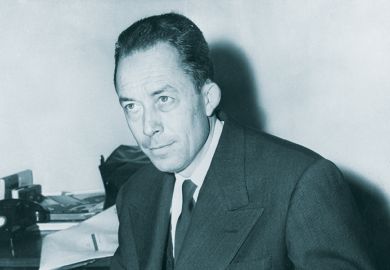How did biography come to be such a popular form over the centuries? Richard Holmes's collection of six major examples provides more evidence of its lasting appeal - perhaps with a hint that brevity is an important virtue. Long biographies - which after Boswell's epic achievement declined into the massive and uncritical appreciations constructed by his Victorian successors - are set aside in favour of more intimate memoirs; meanwhile, the rise of autobiography by Wordsworth and Coleridge, or Darwin, Newman and Ruskin, is little considered.
The popularity of the first writings to be chosen, Daniel Defoe's brief accounts of John Sheppard and Jonathan Wild, are associated with popular journalism and the rise of urban mythology. Just as the Great Train Robbery of 1963 caught the public imagination, so Sheppard intrigued contemporary readers by the ingenuity with which he again and again escaped captivity and by his cleverness in escaping from the shackles and padlocks that were made to restrain him. Middle-class tradespeople, aware of their material losses, might be appalled by the ease with which he escaped, but in the eyes of the general public he became something of a cult hero. The thief-taker Wild, by contrast, was widely unpopular.
Richard Savage, a more aristocratic figure - at least in his own estimation - combined independence of outlook with more disreputable activities, so that the records of his friendship with Samuel Johnson helped to humanise the latter for the modern reader. Boswell was forced to concede something further: "Savage's character was marked by profligacy, insolence and ingratitude: yet, as he undoubtedly had a warm and vigorous, though unregulated mind, had seen life in all its varieties, and been much in the company of the statesmen and wits of his time, he could communicate to Johnson an abundant supply of such materials as his philosophical curiosity most eagerly desired." The immediate success of Johnson's Life provides another example of the appeal brought by popular notoriety. It can have owed nothing to the fame of its author, since at the time of its publication Johnson himself was little known. The recently deceased Savage, on the other hand, had been well enough known in London at that time, with his bafflingly complex character, to provoke curiosity about the details of his career. Something more was furnished by Johnson's account, however, which would be of lasting fascination: the double perspective levelled against this life by an author who could not deny that it had run totally contrary to his own principles yet who must still confess his own sympathy and attraction.
The changes that were being distantly signalled by such effects were shortly to receive more substantial form from Jean Jacques Rousseau, who announced in his Confessions what he believed to be a novel enterprise: "I have begun on a work which is without precedent, whose accomplishment will have no imitator. I propose to set before my fellow mortals a man in all the truth of nature; and this man shall be myself." In the midst of 18th-century urbanity such an effort at complete honesty was indeed a new enterprise, to be followed by a few writers, and even more controversially by William Godwin, who in his life of Mary Wollstonecraft set out to record not only his own experience but hers as well, making no attempt to conceal her sexual openness or the irregularity of their relationship. According to Holmes, the result was to destroy both their reputations for a century - which is no doubt broadly true, but there must have been readers, even then, who found in Godwin's openness a refreshing freedom, and in Wollstonecraft's tragic plight a true pathos. At the very moment when Wollstonecraft lay dying in the childbirth that would produce Shelley's future wife (and thus a further source of scandal) Nelson was engaged in the first of the naval feats that were successful enough for his sexual failings to be quietly overlooked by his contemporaries. At the centre of Holmes's sequence is a surefire success in its time: the Life of Nelson , produced by the upright Richard Southey.
"Cometh the hour, cometh the man" was never truer than of Nelson's career, and his achievement of instant heroism. Just at the moment when Napoleon was carrying all before him on land in Europe, this master of nautical skill destroyed his fleets and denied him naval superiority. The technical vocabulary that accompanied the ability to rely on wind and wave alone is bewildering to the modern reader but was evidently meat and drink to contemporary readers, who could follow every twist and turn of an amazing success story. Southey's story-telling, meanwhile, achieved a not altogether dissimilar feat of its own: within a few months he was made poet laureate. Not everyone was bowled over by Nelson, however. Despite the existence of her admiral brothers, Jane Austen, faced with Southey's volume, was not sure that she wanted to read another life of Nelson - unless, she said, her brother Francis should turn out to be mentioned in it also. Despite the warmth of Austen's feelings towards naval men generally, the contrast between Nelson as a man of action and his controversial private life was evidently not a spectacle she wanted to dwell on.
While in those years the demand for more details concerning such an almost universally agreed hero was avid, how many readers wanted to know about his contemporary, the artist and poet William Blake? He had to wait many years for a proper life to appear at all, despite several brief memoirs. Accordingly, when Alexander Gilchrist's Life , the longest of the biographies chosen by Holmes, was published, his subtitle Pictor Ignotus epitomised the current state of affairs. It was devoted to rendering long-overdue justice, a long-considered labour of love, and was also timely, since it was still just possible for Gilchrist to talk with people who had known Blake and to undertake a painstaking study of the materials available - not only the surviving designs and the literary remains but also personal reminiscences. When dealing with the works themselves, Gilchrist's view was not always uncritical: he was ready to say if he found the work obscure or uncommunicative. He had an excellent eye for the vivid touches of genius to be found throughout, however, and was enviably adept at drawing attention to lesser artists and poets providing the context within which Blake's achievement stood out so sharply. He was even ready to tackle a more difficult question: was Blake simply "mad" in the colloquial sense, or was there a clinical element? Gilchrist devoted a separate chapter to the matter ("Mad or not mad?"), having previously stated, concerning Blake's popular reputation after about 1810, that the term was one that "none who knew the visionary man personally, at any period of his life, thought of applying to him".
The last biography, Scott on Zélide, which will be less familiar to most readers, is the most complex of all. Geoffrey Scott, who discovered copies of Zélide's works in the University Library at Lausanne, was fascinated by the intricacies involved in her relationships. "In the correspondence of lovers," he wrote, "there will be four elements at play - four egoisms to be placated instead of two. And by this grim mathematical law the permutations of possible offence will be calculably multiplied." Perhaps he knew of Sigmund Freud's conjecture that every sexual act was a process in which four persons were involved; at all events Scott soon added to the mathematical possibilities through further liaisons of his own, which were often closely linked to his obsession with Zélide's. Shortly after the publication of Rousseau's Confessions, Coleridge counterpointed his advocacy of an account sparing nothing of the facts, however unpleasant, with a sober and straightforward alternative: "I could inform the dullest author how he might write an interesting book - let him relate the events of his own life with honesty, not disguising the feelings that accompanied them." Between them, the statements by Rousseau and Coleridge indicate the extremes of what is involved in the biographical enterprise. A point that emerges from Holmes's range of examples, however, is that successful biography will often also involve some kind of ambiguity, either in the subject or perhaps in the biographer himself or herself, that engages similar dualities in the spectator - as in Blake's case, where the issue becomes climactic once a sympathetic reader tries to embrace all the fissures implicit in his contradictions and self-contradictions. Here perhaps lies the truest fascination of biography.
John Beer is emeritus professor of English literature, Cambridge University.
Classic Biographies series: Defoe on Sheppard and Wild Johnson on Savage Godwin on Wollstonecraft Southey on Nelson Gilchrist on Blake Scott on Zélide
Editor - Richard Holmes
Publisher - Harper Perennial
Pages - 122, 135, 106, 301, 437 and 192
Price - All £7.99 except Godwin on Wollstonecraft and Johnson on Savage, £6.99
ISBN - 0 00 711168 1, 711169 X, 711176 2, 711170 3, 711171 1 and 711173 8
Register to continue
Why register?
- Registration is free and only takes a moment
- Once registered, you can read 3 articles a month
- Sign up for our newsletter
Subscribe
Or subscribe for unlimited access to:
- Unlimited access to news, views, insights & reviews
- Digital editions
- Digital access to THE’s university and college rankings analysis
Already registered or a current subscriber? Login



